A Lost Gem on Hillsborough Street: The Joe Cox Stained Glass Mural
The gem on Hillsborough St. in 1962 — at night, the way Joe Cox intended it. (Photo courtesy the NC Office of Archives and History, State Archives.)
Forty-seven years ago next month, Branch Banking and Trust Company opened its “State College Office†at the corner of Hillsborough St. and Oberlin Rd. The ribbon cutting ceremony was held with great fanfare, with the mayor of Raleigh, the chancellor of NC State and the president of BB&T in attendance.
Though the pick and shovel groundbreaking had occurred several months earlier, the bank’s opening “broke ground” in another, more significant way — it was the first Raleigh bank to feature a work of public art as an integral part of its design — a dazzling stained glass mural.
“The mural represents the growing cooperation between artist and architect that is rapidly spreading throughout the country,†the N&O reported in an article on the event in 1962.
The architect of the State College Office was F. Carter Williams; the artist who designed the stained glass mural was none other than the renowned Raleigh artist, color theorist and School of Design professor, Joe Cox.
The NC State University BB&T branch as it appears today.
The “striking, three-dimensional stained glass mural†measured 9 x 14 feet, and comprised an entire wall of the bank’s glass-enclosed entry foyer. Stained glass panels of varying sizes and colors — reds, greens, yellows, orange, blues — formed a pattern in a wall of white cast stone. A grid of fixed anodized aluminum vanes placed in front of the glass panels on the exterior of the wall diffused light passing through the stained glass.
This is a view of the stained glass mural from inside the bank foyer in 1962. (Photo courtesy the NC Office of Archives and History, State Archives.)
Although Cox designed the mural specifically for nighttime illumination, it played on natural light throughout the day. As the N&O article described the display: “Morning light streaming through the stained glass openings casts a beautiful pattern of variegated color. The rich colors are reflected faintly in the glass doors that lead from the foyer into the bank itself. In the afternoon, the vanes modulate a pattern of light and shadow …â€
The State College branch under construction in 1962. The cast stone framework is ready for the installation of the stained glass panels. (Photo courtesy the NC Office of Archives and History, State Archives.)
Few people today are aware that Cox created this bejeweled Hillsborough St. landmark. Even fewer remember it.
As a freshman at NC State, I myself vividly recall the day I was in the bank, standing at a teller’s window, when I overheard behind me a young man compliment the female assistant manager: “Forgive me, but you have the most beautiful green eyes I have ever seen!†She thanked him politely as their transaction concluded.
After completing my own transaction I walked past the assistant manager’s desk and made a furtive effort to see for myself what had so smitten the young man. And sure enough, her eyes were a clear, deep emerald green. As I passed through the foyer on my way out, I lingered by the mural with all its sparkling colored glass. I focused on a bright green glass panel and thought—wow!
Another view inside the foyer. (Photo courtesy the NC Office of Archives and History, State Archives.)
Sadly, the Joe Cox stained glass mural, the gem on Hillsborough St., has been lost. In a building renovation 20 or so years ago, the bank remodeled the foyer, and an ATM machine now fills the space this incredible work of art once occupied. Since that time I have always wondered: Where is the mural today?
With the generous assistance of the current branch manager, I am attempting to track down the mural’s fate. I’ll report back with my findings, whether the news be good or bad.
A recent nighttime view of the 1980s remodeling of the entry foyer. The brick walls were lowered, the ATM was installed and the original space occupied by the glass-enclosed foyer was reduced significantly.

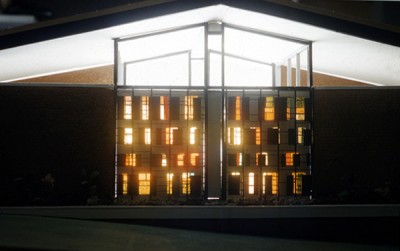
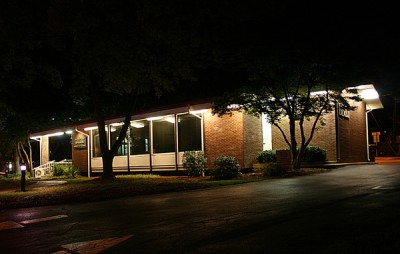
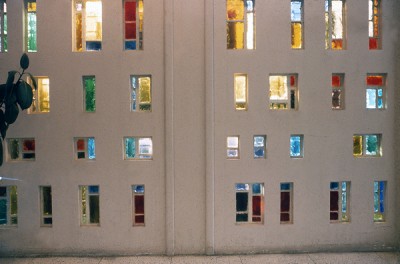
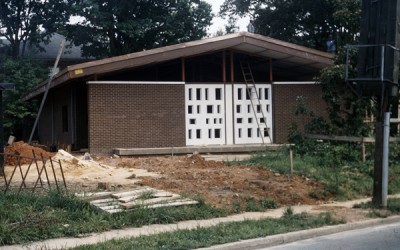
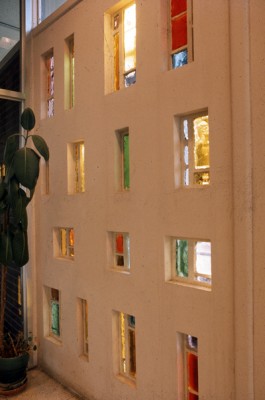
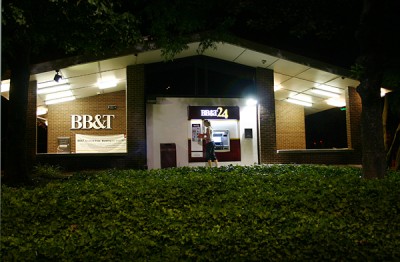
 Sign up for the Newsletter
Sign up for the Newsletter
09/11/2016
Did you ever find the mural?
09/16/2016
The bank mural is reminiscent of the front wall of the sanctuary at Fairmount Temple in Beachwood, Ohio, which was built in the mid-50s:
http://cleveland.reel-scout.com/up_images/9/1135829.jpg
09/29/2016
I was finishing up studies at NCSU in 1980 -82. Found a summer and later part time job in the BB&T branch. I remember the mural was so pretty looking outside during a sunny day. Sadly when the ATM was installed the remodel to house the large “box” that was the ATM destroyed the mural wall. Most of the glass was just broken but I do still have a couple of pieces stored away. Recall Joe Cox was an older man who came in at the time of demolition and shared a few stories. Sad progress removed a beautiful piece of work.